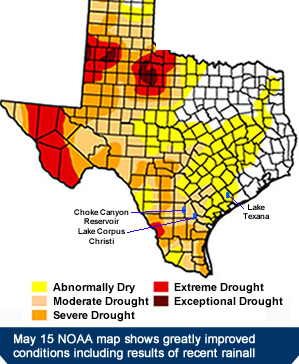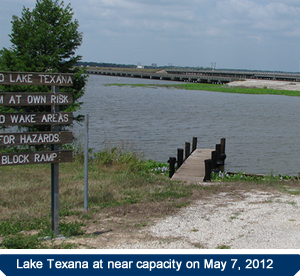Rainfall Turns Coastal Bend Green, Fills Lake Texana and Bumps Up Levels at Lake Corpus Christi & Choke Canyon
May 17, 2012
 The El Nina in the equatorial Pacific is over and normal rainfall has returned to the communities served by the Water District in San Patricio, Aransas and Nueces counties.
The El Nina in the equatorial Pacific is over and normal rainfall has returned to the communities served by the Water District in San Patricio, Aransas and Nueces counties.
An extraordinary rainfall event on April 15 brought more than 15 inches to a concentrated area around Gregory and Portland.
Periodic rains in the areas generally closer to the coastline have improved drought conditions substantially. The Water District service area was still classified as "abnormally dry" or in "moderate drought" as of the May 15 map. Rainfall frequency over the area has increased since December.
Conditions have improved in almost all of Texas and it appears the Drought of 2011 has broken. Rainfall in South Texas is expected  to be near normal through the end of the summer -- months when there is typically little rainfall except when associated with tropical weather.
to be near normal through the end of the summer -- months when there is typically little rainfall except when associated with tropical weather.
Soil moisture in San Patricio County has varied widely this crop season. Most farmers have seen adequate rain to produce at least average crop yields this year. In 2011 most did not make a crop because of extreme drought conditions.
Periodic rains in the Navidad River Basin have kept Lake Texana at more than 90% of capacity since mid-March. It was at historically low levels at the beginning of the year. Motorists on US 59 now see the familiar near-full lake waters under the highway bridge instead of the hundreds of acres of exposed lake bottom that levels dropped more than 14 feet.
Levels in the combined Lake Corpus Christi/Choke Canyon Reservoir system continue to hold near 50% -- the trigger for voluntary elements of the region's Drought Management Plan.
DROUGHT WATER RULES
Triggers in the Drought Management Plan are activated at 50%, 40% and 30% of system storage capacity. When the reservoir system storage drops below 50% of total system capacity, local water provider are to issue a public notice to inform water users to take greater voluntary conservation measures.
When capacity drops to 40% water providers will implement mandatory restrictions including time of day outdoor watering restrictions. Residents and businesses will be restricted from using water for irrigation of vegetation between the hours of 10:00 a.m. and 6:00 p.m. Under the 40% restrictions no person may: (1) allow water to run off from yards or plants into gutters or streets, (2) allow defective plumbing in a home or business to remain unaddressed or (3) allow water to flow constantly through a tap, hydrant, valve, or otherwise by any user of water connected to the municipal system. At 30% of reservoir capacity residential lawn watering will be sharply restricted to specific days in an effort to reduce demand further.








